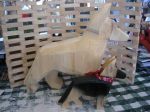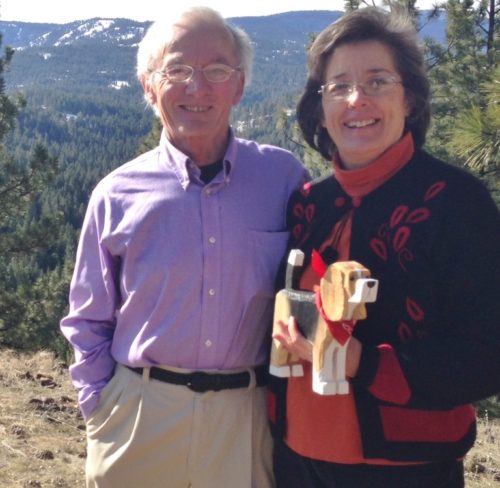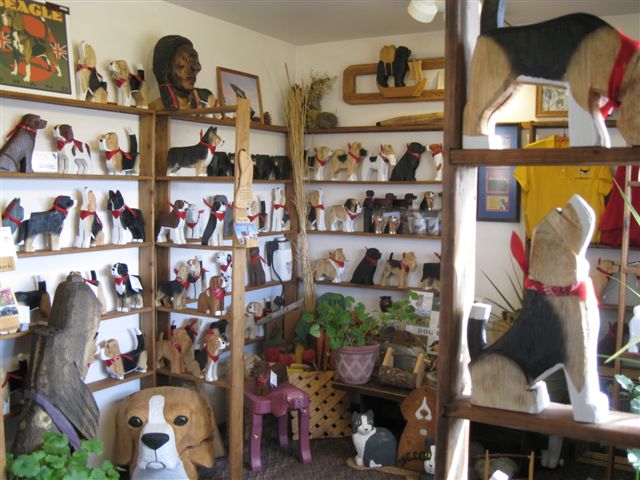What seems uninteresting & unremarkable to artists is often not the case for non-artists. Many times artists’ fans & collectors are fascinated by the seemingly mysterious processes involved in the making of art.
This blog will describe some of the processes we use in our studio at Dog Bark Park to create a chainsaw-carved dog carving, specifically a German Shepherd Dog.
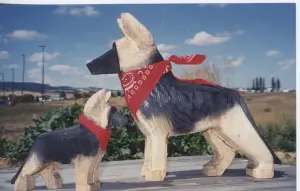
Using a gas Stihl chainsaw we cut a slab of wood from a log stored outdoors in our log yard. Imagine the large log being rather like a loaf of bread that is sliced into appropriate thicknesses for the various uses intended for the bread; perhaps thicker for french toast & thinner for sandwiches, for example. Similarly, we cut the log slice to the appropriate thickness for the size of the piece planned.
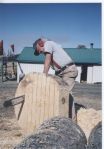
We bring the freshly cut slab into our studio where the rest of the chainsaw work is done using an electric Stihl saw. We begin by drawing an outline of the desired dog on the slab, being mindful to “read” the wood to avoid placing a knot or other undesirable characteristic in a location that might compromise the final outcome of the carving. A large knot on the nose of the dog, for instance, is detrimental to the structural & cosmetic integrity of the piece.
Dennis then begins cutting away in large chunks any wood outside the German Shepherd shape penciled on the wood. Eventually the dog begins to emerge into a 3-dimensional piece as the carving process continues as he reduces the thickness of the nose, makes the cuts to fashion the ears, tail, feet and so forth. The final stages include rounding all the squared edges to give a finished more natural look to the dog. The scrap wood scattered on the floor around the wood carving platform after the piece is finished is a large volume of wood than what is in the finished piece. All this scrap is stored becoming our fuel for heating the studio.
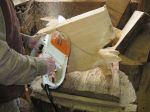
After being carved the dog is set aside, either indoors near the wood stove in winter or outdoors when sunny weather prevails, for a few days or couple of weeks to dry before prepping the carving for painting. How long a piece takes to cure depends on moisture levels in the wood, the ambient air humidity & such factors.
When cured, the dog is given eye & nostril cuttings using a Dremel tool. The dog is brushed to remove any thick globs of sawdust and then it is lightly burned with a propane torch to burn off any remaining loose material as well as any residual chainsaw oil. The burning also provides a final cure & adds color to the pine wood.
The German Shepherd carving is then taken outdoors to a painting table to spray paint on the black saddle markings. At least two coats are applied, with drying time of a few hours or couple of days between coats. Next the dog is moved to our studio paint table where its eyes and nostrils are hand-painted black. Final finishing includes affixing a brass license tag to the dog’s upper chest, tying a red fabric neckerchief around its neck & attaching hang tag.
At most times of the year our carvings are made to order, meaning they will be packaged for pick-up or mailing to customers upon their completion. This process is often called on-demand manufacturing. In any case, what it means for us is that typically our carvings sell faster than we can replace inventory in our shop store. We do try to maintain an inventory of at least 50 small-size carvings of various breeds at any one time to be able to fulfill orders for them quickly.
Somehow this large-size German Shepherd
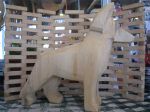
has not been spoken for. We have left it “naked” for the time being in the event someone is interested to have a white shepherd, all black one, or one with markings different from the typical black saddle & muzzle. If ordered this week we could still complete paint and ship the Shepherd to arrive before Dec 25th.
